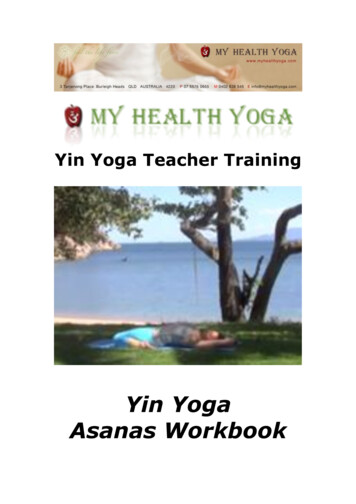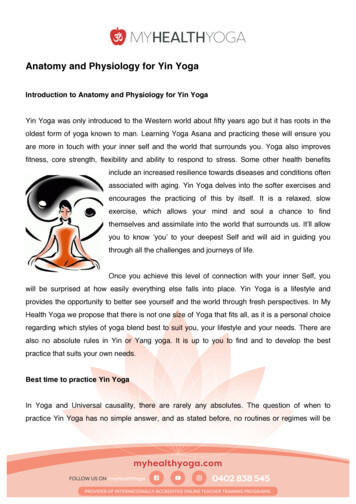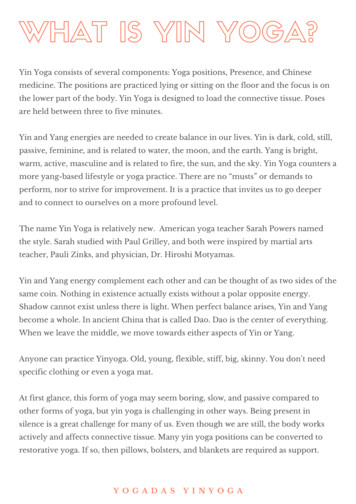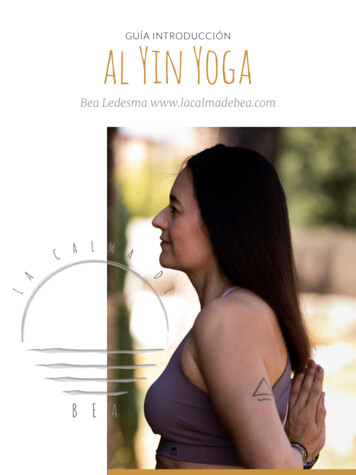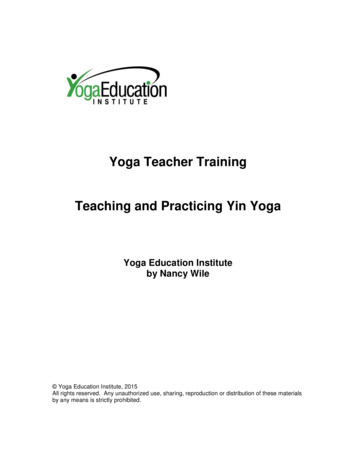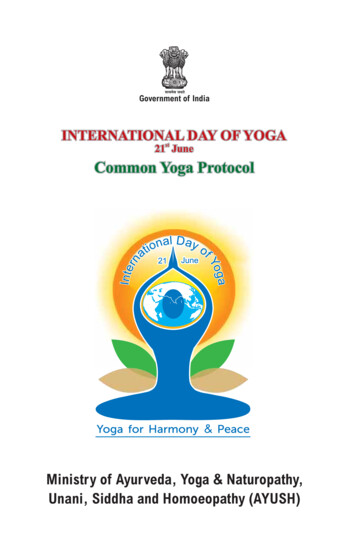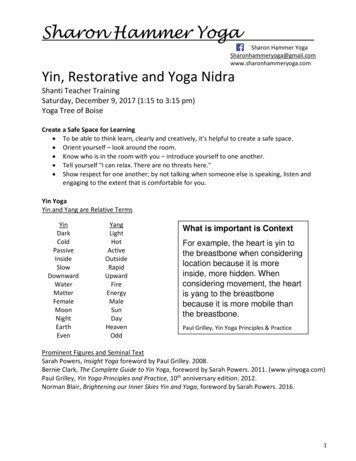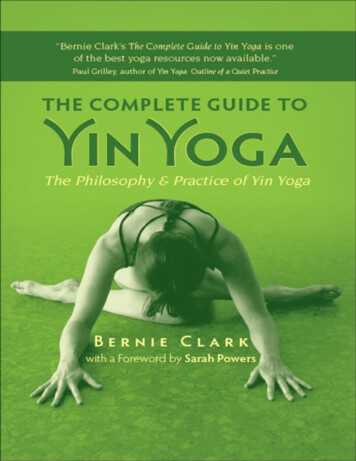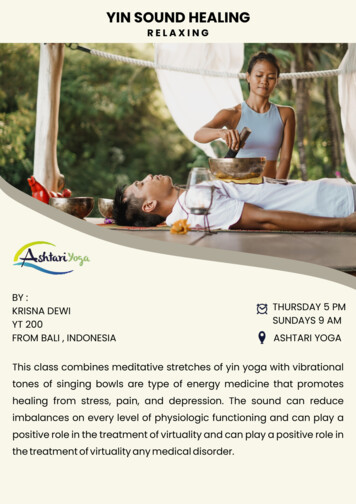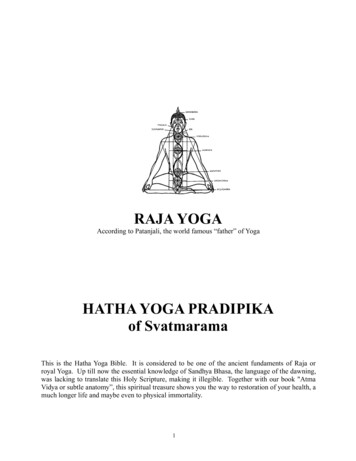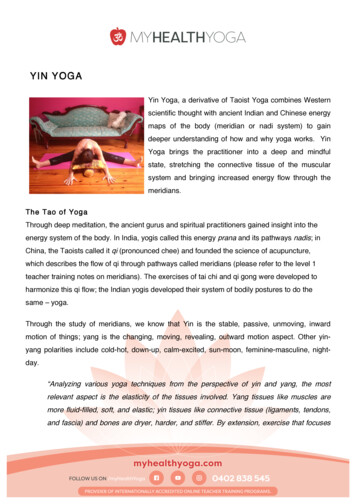
Transcription
YIN YOGAYin Yoga, a derivative of Taoist Yoga combines Westernscientific thought with ancient Indian and Chinese energymaps of the body (meridian or nadi system) to gaindeeper understanding of how and why yoga works. YinYoga brings the practitioner into a deep and mindfulstate, stretching the connective tissue of the muscularsystem and bringing increased energy flow through themeridians.The Tao of YogaThrough deep meditation, the ancient gurus and spiritual practitioners gained insight into theenergy system of the body. In India, yogis called this energy prana and its pathways nadis; inChina, the Taoists called it qi (pronounced chee) and founded the science of acupuncture,which describes the flow of qi through pathways called meridians (please refer to the level 1teacher training notes on meridians). The exercises of tai chi and qi gong were developed toharmonize this qi flow; the Indian yogis developed their system of bodily postures to do thesame – yoga.Through the study of meridians, we know that Yin is the stable, passive, unmoving, inwardmotion of things; yang is the changing, moving, revealing, outward motion aspect. Other yinyang polarities include cold-hot, down-up, calm-excited, sun-moon, feminine-masculine, nightday.“Analyzing various yoga techniques from the perspective of yin and yang, the mostrelevant aspect is the elasticity of the tissues involved. Yang tissues like muscles aremore fluid-filled, soft, and elastic; yin tissues like connective tissue (ligaments, tendons,and fascia) and bones are dryer, harder, and stiffer. By extension, exercise that focuses
on muscle tissue is yang; exercise that focuses on connective tissue is yin.” (PaulGrilley)There is a movement in Western forms of yoga towards a more ‘yang’ practice such a vinyasa,power, and ashtanga yoga. These styles of yoga infuse the muscles with blood, as do standingposes, Sun Salutations, or inversions. Once the muscles fill with blood, they become mucheasier to stretch.Yang-style yoga is wonderful for detoxing the body and emotions,conditioning the cardiovascular system and strengthening the muscles and mind. It could bedebated that deep flexibility and stillness of mind, however, is generally not achieved throughyang-style asanas to the degree to which yin yoga practice can. Yin-style yoga of holdingposes for at least 5 minutes, brings greater flexibility to the body through the release of theconnective tissue. Yin poses also develop the ability to meditate within the asana, giving rise toa greater ability to sit for longer periods of time in seated meditation (one of the ultimate goals ofasana practice).The Joint Stretch“Why would Yin Yoga advocate stretching connective tissue? We must remember thatconnective tissue is different from muscle and needs to be exercised differently. Insteadof the rhythmic contraction and release that best stretches muscle, connective tissueresponds best to a slow, steady load. If you gently stretch connective tissue by holding ayin pose for a long time, the body will respond by making them a little longer andstronger—which is exactly what you want. “ (Paul Grilley)Yin tissues that we are targeting are the denser, deeper, less elastic tissues, such as theligaments, joint capsules, cartilage, bones and fascial networks of the body. Whilst connectivetissue is found in every bone, muscle, and organ, for yin yoga, we are most concerned morewith the connective tissue in the joints. If you don't use your full range of joint flexibility, theconnective tissue will slowly shorten to the minimum length needed for your everyday activities.Prolonged shortening of connective tissue will bring rigidity and inflexibility into the joints,minimizing physical activity, and making the body more susceptible to injury.Level 2 Yoga Teacher Training Yin Yoga Module PAGE 2 OF 8
The Yin Yoga AsanasLike partner yoga, we can assign any creative name to our yin yoga asanas. There’s no right orwrong and like any standard yoga pose, there are variations of the pose names from school toschool. The idea is to take traditional hatha yoga seated postures (no standing poses in yinyoga as it is not comfortable to hold for long periods of time) and adapt them. Each student willlook different within the pose based on their intuitive and healing needs. Props are essential tobring deep comfortability. Yin Yoga is a cooling practice and as such only a light warm-up of afew sun salutes is needed. Be sure to have blankets on hand for students as the body coolswithin the asana. Cooling is a natural response when a person experiences a healing release.Shivering is actually encouraged as it creates a release of tension – this is the nervous system’sprimary reflex to unlock subconscious blocks in the body/mind. The prana literally shakesthrough the blocks, releasing what no longer serves our higher good. This phenomenon alsohappens within yang style yoga practice and an unaware teacher or practitioner may seek tocontrol these involuntary movements, incorrectly believing they are fatigued. The shaking orpulsing must be encouraged for deep cellular healing. It is not uncommon for an orgasmicfeeling to be experienced if the shaking is allowed to continue as all nadis (meridians) andchakras will ultimately explode with light and prana (specifically Shakti energy – the feminineprinciple).It is important in yin yoga stretches to be very physically comfortable. Observe your facialexpressions – the face needs to be relaxed – any tightening of the face is a sign to ease off.Proceed cautiously, gradually extending the depth of poses and the length of time you spend inthem (poses can be held up to 20 minutes, however, we may term this ‘Restorative Yoga’).The Three Tattvas of Yin Yoga PracticeA tattva is the reality of a thing, or its category or principal nature. Sarah Powers offers us threevery simple and very effective principles for the yin practice.1. Come into the pose to an appropriate depthLevel 2 Yoga Teacher Training Yin Yoga Module PAGE 3 OF 8
2. Resolve to remain still3. Hold the pose for timeTo give a deeper understanding of the Three Tattvas on Yin Yoga Practice, we can expand oneach point:1. Bring your student into the pose to their full extension initially so they are aware of wherethe point of resistance is within the pose. If we were to hold the asana at full extensionfor five minutes, we would injure ourselves – therefore, ask your student to ease backfrom the full extension to a place where they are simultaneously comfortable but stillfeeling energy (prana) in their meridians (ie. still feeling a gentle release). Yin Yogaencourages the practitioner to find their own natural, organic shape within the pose. Ifyour intuition wants you to turn your head to the side; bend your knee/elbow; round yourspine etc, you must do so. The body has it’s own divine intelligence and will move to aplace within the pose that will conduct the best throughput of energy, providing thehighest form of healing. Each body is different and if there has been repetitive movementand injury within the body, it may be appropriate to find a shape within the body that best‘unravels’ the blockage. This can be counter-intuitive to the strict alignment techniqueswithin other styles of yoga and can challenge many experienced ‘yang’ style yogapractitioners. Be prepared to break all the rules and listen to the inner guidance!2. If you cannot remain still within the pose, you need to keep modifying the asana until youcan. Meditation is the goal here. Small movement is allowed to deeepen into a pose asthe mind/body relaxes. Exploring deeper states of consciousness within facilitated bythis powerful internal practice can mean the body will suddenly ‘unlock’ long-heldblockages. As such, the practitioner is allowed to move to deepen the pose as feelsappropriate. Fidgeting, sratching, looking around etc is distracting and not encouraged.No darting gaze is allowed either and it is recommended that there is no dristhi, ratherthe eyes are closed.3. 5 minutes is recommended in a yin yoga pose due to the fact that it takes 2.5minutes torelease the connective tissue, hence the remaining 2.5minutes is where the healing takesLevel 2 Yoga Teacher Training Yin Yoga Module PAGE 4 OF 8
place.Healing Practices within Yin Yoga AsanasHolding asanas for 5 minutes gives ample time and opportunity to do practices such asvisualisation and mantra (affirmation).Yin Yoga postures focus on releasing the major joints of the body. Write down appropriate YINposes (comfortable to hold for 5 minutes) plus a visualisation and mantra (or affirmation) for:SHOULDER JOINT:HIP JOINT:KNEE JOINT:ANKLE JOINT:ELBOW & WRIST JOINT:NECK:Level 2 Yoga Teacher Training Yin Yoga Module PAGE 5 OF 8
The Flow of Qi“Even if you only spend a few minutes a couple times a week practicing several of theseposes, you'll be pleasantly surprised at how different you feel when you sit to meditate.But that improved ease may not be the only or even the most important benefit of YinYoga. If Hiroshi Motoyama and other researchers are right—if the network of connectivetissue does correspond with the meridians of acupuncture and the nadis of yoga—strengthening and stretching connective tissue may be critical for your long-term health.Chinese medical practitioners and yogis have insisted that blocks to the flow of vitalenergy throughout our body eventually manifest in physical problems that would seem,on the surface, to have nothing to do with weak knees or a stiff back. Much research isstill needed to explore the possibility that science can confirm the insights of yoga andTraditional Chinese Medicine. But if yoga postures really do help us reach down into thebody and gently stimulate the flow of qi and prana through the connective tissue, YinYoga serves as a unique tool for helping you get the greatest possible benefit from yogapractice.” (Paul Grilley)Level 2 Yoga Teacher Training Yin Yoga Module PAGE 6 OF 8
MERIDIAN THERAPY - WRITE DOWN YIN POSES TO OPEN:LUNG MERIDIAN:LARGE INTESTINE MERIDIAN:STOMACH MERIDIAN:SPLEEN MERIDIAN:HEART MERIDIAN:SMALL INTESTINE MERIDIAN:BLADDER MERIDIAN:KIDNEY MERIDIAN:PERICARDIUM MERIDIAN:SANJIAO (TRIPLE-WARMER) MERIDIAN:GALLBLADDER MERIDIAN:LIVER MERIDIAN:DU (GOVERNING)MERIDIAN:REN (CONCEPTION) MERIIDIAN:Level 2 Yoga Teacher Training Yin Yoga Module PAGE 7 OF 8
Level 2 Yoga Teacher Training Yin Yoga Module PAGE 8 OF 8
Level 2 Yoga Teacher Training Yin Yoga Module PAGE 2 OF 8 on muscle tissue is yang; exercise that focuses on connective tissue is yin." (Paul Grilley) There is a movement in Western forms of yoga towards a more 'yang' practice such a vinyasa, power, and ashtanga yoga.
